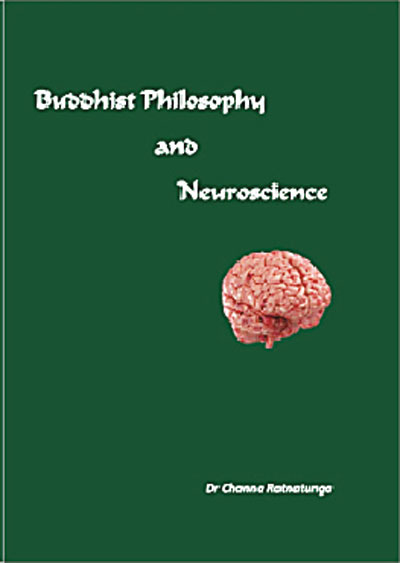Sunday Times 2
Whither human evolution?
View(s):Dr Channa Ratnatunga
Seeing on media portals the current madness of a lack of human maturity, one wonders if and when humans will evolve beyond the tribal attitudes that were a hallmark of primitive societies! Would we as Homo sapiens ever evolve beyond the current mindset? It would be difficult to envisage, though, the other extreme, a world full of ‘Arahaths for Arahaths,’ if I might say—with tongue in cheek, ‘it may be a bit boring!
That we as humans must evolve beyond the primordial violence that we see around us; mortals versus mortals, nations versus nations, the lop-sided bias for the Northern states vis-à-vis those in the South, and the primitive mentation that ‘might is right’ all reflect the ‘Sapiens’ brains as needing ‘evolution.’

Mindful meditative practices are our legacy from the civilised East of yesteryear
Trying to remain within the perimeter of ‘evidence-based’ secular thought, I had a few glimmers of hope. It was the prefrontal lobes of the Sapiens brain that sculpted our early evolution from other hominid species some 120,000-200,000 years ago in the African Continent. Primordial instincts for survival and procreative needs for the continuation of the species were a priority at all costs at that time. These held sway till herds and societies induced morality and conscience as a necessity to maintain social harmony into the equation. This ability to say ‘no’ to these instinctual acts enhanced the cerebral cortical structure of Sapiens networks in the prefrontal regions (see fig.) of the brain in those selectively able to moralise their cognitive attitudes. Every society has such individuals who, by virtue of their thoughtful responses to crises, are admired and appreciated. A step in human evolution! Digging deeper as to the underlying neuronal networks in the brains of such individuals, it features a structurally transformed brain.
The brains of humans have seven main neuronal networks developed by neuroplasticity. Thought-related networks of the brain are the Default Mode Network (DMN), the Salience Network (SN) and the Central Executive Network (CEN)—a task-based network. Located as they are in the prefrontal cortex with connections to other relevant areas of the brain, the DMN is mainly survival based, with rumination on self-referential thoughts and retrieval of memories. CEN is task-based and focused in the ‘now.’ The SN helps to switch between the former two. Remaining in the CEN persistently over months and years makes such task-based thoughts of the ‘now’ become a trait as different from a state. The CEN attenuates the DMN activity, with a reciprocal enlargement of the CEN cerebral cortical structures. Staying always in the ‘Now’ by mindful meditation transforms the being to be calm, thoughtful, and compassionate, with a strong equanimous mind. Human mental evolution achieved by non-natural selection!
The earliest appreciation of the benefits of a contemplative mind-set was discovered in the interglacial period, in the Gangetic Valley civilisation (700-500 BCE), dominated by yogis practicing focused attention and deep concentration, well described in the Vedas and Upanishads. Siddhartha Gautama sought and achieved the acme of such an effort when he began to see the ultimate reality of existence. He was described as ‘the Awakened One—the Buddha.’
Education is the crux of mentation. Research indicates mindfulness training can significantly improve students’ attention, emotional regulation, and academic performance. These mindful meditative practices are our legacy from the civilised East of yesteryear. They are practised in Tibetan schools as a part of the Buddhist curriculum and also in some institutes in India, Thailand, Bhutan, Vietnam, and Myanmar. Further mindful meditation (to avoid stress) has been adopted by many state schools in the US in their school curricula after the age of twelve. Its implementation in the classroom helped both students and teachers. The statistics quoted show improved academic performance: improved GPA (Grade Point Average) by 9-15.4%. Improved grades in most subject areas, including math by 18-28%, science by 20-23%, reading by 9-18%, social studies by 12-30%, and writing by 9-13%.
Further, change in demography in the US has precipitated an epidemic of social isolation in the elderly with its consequent sense of loneliness. Mindfulness practices have been shown to be useful tools that can help individuals better understand and manage the emotional and physical consequences of loneliness, as well as cultivate a greater sense of connection and well-being through interactions and new or lapsed friendships, family, and community engagement. As much social stress is now leading to increased prevalence of heart disease, strokes, cancer, depressive illness, chronic inflammatory disease, etc. Mindful meditation minimises the stress response. Small groups with like interests go on meditative retreats in many countries. Current communication technologies have expanded this to communities with like interests; hopefully they may grow into ‘movements’ that may eventually change mankind.
Mindful meditation could be a direction in future human evolution, not through the normal biological sense of natural selection of random genetic mutation, but through conscious, intentional evolution of the mind and hence society.
Should we too, in Sri Lanka, contemplate inclusion of mindful meditation in school curricula, the concept of the ‘Sati-Pasala’? I must mention a similar practice for Peradeniya medical students—in fact, all comers from the Peradeniya University—daily early morning in the Department of Anatomy carried out without much fanfare by Prof. Eugene Wickremanayake in the 1990s till, I think, her demise in 2020.
| Buddhist Philosophy and Neuroscience Some of the subjects discussed in this article are detailed in my 150 page book ‘Buddhist Philosophy and Neuroscience’, sold at Sarasavi Bookshop outlets and BPS outlets at Rs 800 copy. The money so accrued is entirely used to fund the Migara Trust Fund. Which funds needy medical students of the University of Peradeniya. A companion volume ‘The Conditioned Self’ is due out soon.
| |


